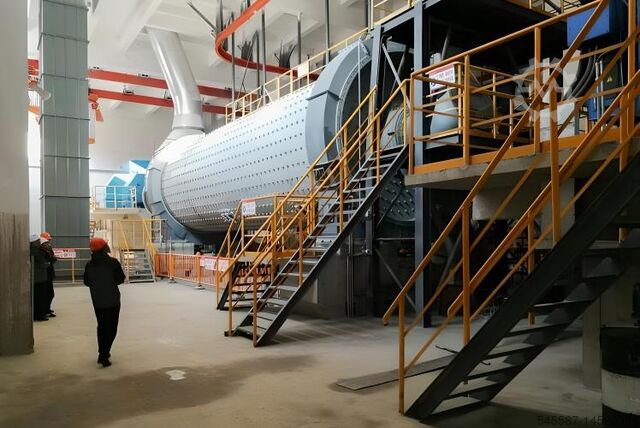โรงสีปูนซิเมนต์,โรงบดปูนเม็ดClinker grinding mill / cement ball mill
cement grinding with air classifier
โรงสีปูนซิเมนต์,โรงบดปูนเม็ด
Clinker grinding mill / cement ball mill
cement grinding with air classifier
VB ยังไม่รวมภาษีมูลค่าเพิ่ม
US$116,000
ปีที่ผลิต
2025
สภาพ
ใหม่
ที่ตั้ง
Zheng Zhou Shi 

รูปภาพแสดงให้เห็น
แสดงแผนที่
ข้อมูลเกี่ยวกับเครื่องจักร
- ชื่อเครื่องจักร:
- โรงสีปูนซิเมนต์,โรงบดปูนเม็ด
- ปีที่ผลิต:
- 2025
- สภาพ:
- ใหม่
- ประสิทธิภาพการทำงาน:
- ทำงานได้เต็มประสิทธิภาพ
ราคาและสถานที่
VB ยังไม่รวมภาษีมูลค่าเพิ่ม
US$116,000
- ที่ตั้ง:
- Dahuangye Industrial zone, XinXing East RD, Gongyi, 451200 Zhengzhou, China

โทร
รายละเอียดข้อเสนอ
- รหัสประกาศ:
- A14520358
- อัปเดต:
- อัปเดตล่าสุดเมื่อ 05.04.2568
คำอธิบาย
A cement clinker grinding mill is a specialized equipment used to grind the hard nodular clinker into fine powder, which is cement. Most cement is currently ground in ball mills and also vertical roller mills, which are more effective than ball mills.
Here are key features and information about cement clinker grinding mills:
1. Raw Materials:
- The main raw material for making cement is clinker, which is produced by sintering limestone and clay. Other materials such as gypsum, fly ash, or slag may also be added during the grinding process to achieve specific properties.
2. Grinding Process:
- The clinker and other additives are finely ground in the grinding mill to produce cement. The grinding process is a crucial step in cement production and contributes significantly to the final quality of the product.
3. Types of Mills:
- Ball Mills: Traditional ball mills are commonly used for grinding clinker. They operate by rotating a cylinder with steel grinding balls, causing the balls to fall back into the cylinder and onto the material to be ground.
- Vertical Roller Mills (VRM): VRM technology has become increasingly popular for clinker grinding. These mills use a rotating table with rollers to crush and grind the clinker, providing energy efficiency and a smaller footprint compared to ball mills.
4. Gypsum Addition:
- Gypsum is often added during the grinding process to control the setting time of the cement. It prevents flash setting of the clinker and facilitates the formation of a workable and pumpable cement paste.
Blodpfx Afsq Nfbhjdor
5. Quality Control:
- Quality control measures, such as monitoring the fineness of the cement, chemical composition, and other properties, are implemented during the grinding process to ensure the final product meets the required specifications and standards.
6. Clinker Cooling:
- Before grinding, the clinker is produced by heating the raw materials in a kiln. The clinker is then cooled before entering the grinding mill to prevent excessive heat build-up during grinding.
7. Dust Collection and Environmental Considerations:
- Dust collectors and air pollution control systems are often employed to capture and control the dust generated during the grinding process, addressing environmental and safety concerns.
8. Packaging and Storage:
- After grinding, the cement is typically stored in silos before being packaged in bags or dispatched in bulk for distribution to construction sites or for sale in the market.
Cement clinker grinding mills play a crucial role in the cement production process, and advancements in technology continue to improve the efficiency and environmental sustainability of the grinding process.
Here are key features and information about cement clinker grinding mills:
1. Raw Materials:
- The main raw material for making cement is clinker, which is produced by sintering limestone and clay. Other materials such as gypsum, fly ash, or slag may also be added during the grinding process to achieve specific properties.
2. Grinding Process:
- The clinker and other additives are finely ground in the grinding mill to produce cement. The grinding process is a crucial step in cement production and contributes significantly to the final quality of the product.
3. Types of Mills:
- Ball Mills: Traditional ball mills are commonly used for grinding clinker. They operate by rotating a cylinder with steel grinding balls, causing the balls to fall back into the cylinder and onto the material to be ground.
- Vertical Roller Mills (VRM): VRM technology has become increasingly popular for clinker grinding. These mills use a rotating table with rollers to crush and grind the clinker, providing energy efficiency and a smaller footprint compared to ball mills.
4. Gypsum Addition:
- Gypsum is often added during the grinding process to control the setting time of the cement. It prevents flash setting of the clinker and facilitates the formation of a workable and pumpable cement paste.
Blodpfx Afsq Nfbhjdor
5. Quality Control:
- Quality control measures, such as monitoring the fineness of the cement, chemical composition, and other properties, are implemented during the grinding process to ensure the final product meets the required specifications and standards.
6. Clinker Cooling:
- Before grinding, the clinker is produced by heating the raw materials in a kiln. The clinker is then cooled before entering the grinding mill to prevent excessive heat build-up during grinding.
7. Dust Collection and Environmental Considerations:
- Dust collectors and air pollution control systems are often employed to capture and control the dust generated during the grinding process, addressing environmental and safety concerns.
8. Packaging and Storage:
- After grinding, the cement is typically stored in silos before being packaged in bags or dispatched in bulk for distribution to construction sites or for sale in the market.
Cement clinker grinding mills play a crucial role in the cement production process, and advancements in technology continue to improve the efficiency and environmental sustainability of the grinding process.
ผู้จัดหา
หมายเหตุ: ลงทะเบียนฟรีหรือเข้าสู่ระบบ, เพื่อเข้าถึงข้อมูลทั้งหมด
ลงทะเบียนตั้งแต่: 2024
ส่งคำขอ
โทรศัพท์ & แฟกซ์
+86 150 9... โฆษณา
ประกาศของคุณถูกลบเรียบร้อยแล้ว
เกิดข้อผิดพลาด



















